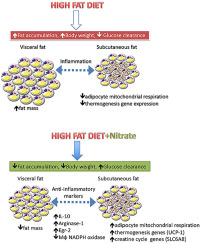Redox Biology ( IF 10.7 ) Pub Date : 2019-11-18 , DOI: 10.1016/j.redox.2019.101387 M Peleli 1 , D M S Ferreira 1 , L Tarnawski 2 , S McCann Haworth 1 , L Xuechen 1 , Z Zhuge 1 , P T Newton 1 , J Massart 3 , A S Chagin 4 , P S Olofsson 2 , J L Ruas 1 , E Weitzberg 5 , J O Lundberg 1 , M Carlström 1

|
Emerging evidence indicates that dietary nitrate can reverse several features of the metabolic syndrome, but the underlying molecular mechanisms still remain elusive. The aim of the present study was to explore mechanisms involved in the effects of dietary nitrate on the metabolic dysfunctions induced by high-fat diet (HFD) in mice. Four weeks old C57BL/6 male mice, exposed to HFD for ten weeks, were characterised by increased body weight, fat content, increased fasting glucose and impaired glucose clearance. All these metabolic abnormalities were significantly attenuated by dietary nitrate. Mechanistically, subcutaneous primary mouse adipocytes exposed to palmitate (PA) and treated with nitrite exhibited higher mitochondrial respiration, increased protein expression of total mitochondrial complexes and elevated gene expression of the thermogenesis gene UCP-1, as well as of the creatine transporter SLC6A8. Finally, dietary nitrate increased the expression of anti-inflammatory markers in visceral fat, plasma and bone marrow-derived macrophages (Arginase-1, Egr-2, IL-10), which was associated with reduction of NADPH oxidase-derived superoxide production in macrophages. In conclusion, dietary nitrate may have therapeutic utility against obesity and associated metabolic complications possibly by increasing adipocyte mitochondrial respiration and by dampening inflammation and oxidative stress.
中文翻译:

硝酸盐饮食通过涉及更高的脂肪细胞呼吸作用和炎症状态改变的机制来减轻高脂饮食诱导的肥胖。
越来越多的证据表明,饮食中的硝酸盐可以逆转新陈代谢综合症的某些特征,但是其潜在的分子机制仍然难以捉摸。本研究的目的是探究饮食中硝酸盐对小鼠高脂饮食(HFD)引起的代谢功能障碍影响的机制。暴露于HFD十周的四周大的C57BL / 6雄性小鼠的特征是体重增加,脂肪含量增加,空腹血糖增加和葡萄糖清除率受损。饮食中的硝酸盐可大大减轻所有这些代谢异常。从机理上讲,暴露于棕榈酸酯(PA)并用亚硝酸盐处理的皮下原代小鼠脂肪细胞显示出更高的线粒体呼吸作用,总线粒体复合物的蛋白表达增加,生热基因UCP-1以及肌酸转运蛋白SLC6A8的基因表达升高。最后,饮食中的硝酸盐增加了内脏脂肪,血浆和骨髓衍生的巨噬细胞(Arginase-1,Egr-2,IL-10)中抗炎标志物的表达,这与NADPH氧化酶衍生的超氧化物生成减少有关。巨噬细胞。总之,饮食中的硝酸盐可能通过增加脂肪细胞线粒体的呼吸作用以及减轻炎症和氧化应激而具有治疗肥胖症和相关代谢并发症的作用。血浆和骨髓来源的巨噬细胞(Arginase-1,Egr-2,IL-10),这与减少巨噬细胞中NADPH氧化酶来源的超氧化物的产生有关。总之,饮食中的硝酸盐可能通过增加脂肪细胞线粒体的呼吸作用以及减轻炎症和氧化应激而具有治疗肥胖症和相关代谢并发症的作用。血浆和骨髓来源的巨噬细胞(Arginase-1,Egr-2,IL-10),这与减少巨噬细胞中NADPH氧化酶来源的超氧化物的产生有关。总之,饮食中的硝酸盐可能通过增加脂肪细胞线粒体的呼吸作用以及减轻炎症和氧化应激而具有治疗肥胖症和相关代谢并发症的作用。










































 京公网安备 11010802027423号
京公网安备 11010802027423号